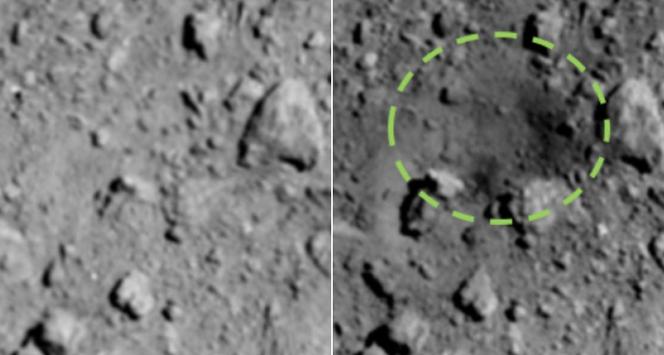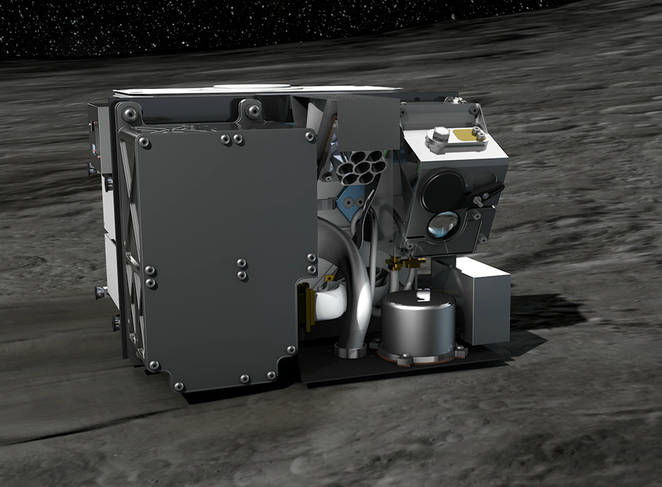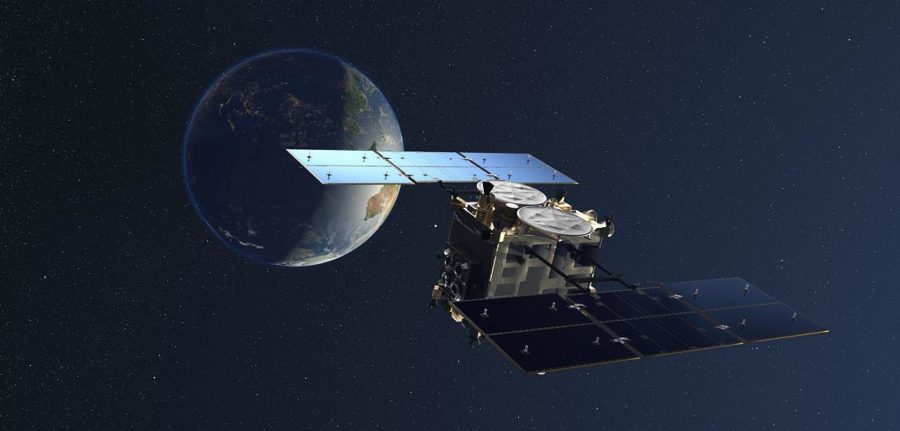On the night of 5-6 December, a very special package landed in the South Australian desert region of Woomera. It contained samples of dust brought back from asteroid Ryugu, after a long journey by the Hayabusa2 spacecraft. These tiny grains of material should speak volumes about the earliest moments of the Solar System.
“Returning these samples was the mission’s main goal,” explains Patrick Michel, senior researcher at the Joseph-Louis Lagrange Laboratory1 and a member of the Hayabusa22 scientific team, as well as of the Hera,3 MMX4 and OSIRIS-REx5 missions. “Ryugu is a carbonaceous asteroid, a category so primitive that its composition isn’t thought to have changed since the formation of the Solar System. It should therefore contain all the ingredients needed to make planets. We also hope to discover the role of asteroids in the emergence of life on Earth and find out whether the organic matter present on their surface was a precursor.”
A guitarist secures a safe landing
Before getting to this point, the Hayabusa2 mission had blasted off from Earth in late 2014, reaching Ryugu in June 2018. After a series of highly risky manoeuvres, the spacecraft left the asteroid in November 2019 and has now just returned. The journey there and back has been unanimously hailed as a remarkable success, even though some dramatic incidents occurred along the way.
At a distance of 300 million kilometres, signals took tens of minutes to travel from the spacecraft to mission control. This difficulty was compounded by lack of knowledge of carbonaceous asteroids, which had never been observed at such close range. So it was only at the last minute that the researchers realised that Ryugu was covered not only with fine regolith, a kind of dust found for example on the surface of the Moon, but also with numerous boulders.
However, the initial strategy was to look for relatively flat landing and contact sites at least fifty metres across. Using 2D photographs taken from above, the teams had to identify which obstacles were less than one metre high, so as not to hamper Hayabusa2’s operations. To do so, they had to rely on a 3D technique for observing differences in shadows and phases, a skill possessed by a most unexpected specialist.
“Our expert in stereo images is Brian May,6 the lead guitarist of the rock band Queen,” smiles Michel. “As he was performing in Milan when we received the first images of Ryugu, I drove down from my lab in Nice to meet up with him. We produced the stereo-pair images of the asteroid backstage.”
Much more than a sample collection
For want of a suitable site, the first sample collection was abandoned in order to define and test a new sampling strategy, so as to maintain the original goal of bringing back a hundred milligrams of material. Although this is considerably less than the sixty grams of dust that the OSIRIS-REx mission hopes to collect from another asteroid, the Japanese mission did much more than just take samples.
In September 2018 two small rovers landed on Ryugu. Equipped with cameras and accelerometers, they revealed – much to the researchers’ surprise – an extremely dark, rough terrain, with a surface devoid of any fine particles. The following month, the MASCOT7 lander was successfully deployed and surveyed the surface at very high resolutions. Unfortunately, one of the four instruments on board, the MicrOmega microscope, was unable to take images due to a tricky touchdown that positioned it poorly. However, another version of the instrument will be used to analyse the samples returned to Earth.

The latter were collected in a horn resembling a mosquito’s proboscis. When Hayabusa2 made contact with Ryugu’s surface it fired a small projectile. In a so-called “touch and go” operation, the dust generated by the impact was captured in just one second, and the spacecraft then climbed away. The mission subsequently carried out a high-velocity impact experiment that was of crucial importance, since the number and size of craters on celestial bodies are used to estimate the age of their surface. Hayabusa2 fired a two-kilogram copper half-sphere at a speed of 2 km/s. However, the crater produced was much larger than predicted, showing the scientists that their models still needed refining.
Despite the risks, the team decided to recover samples of ejected material near the freshly excavated crater. As this material had until then been protected from solar radiation, its composition was likely to be different from that of rocks collected from the surface. Only then was Hayabusa2 able to set out on its return journey.
MicrOmega, the camera that probes matter
The data already available, as well as that to be obtained from the samples returned to Earth, will keep scientists busy for years to come. “This mission is a continuation of Rosetta and its lander Philae, namely the in-situ observation of the most primordial organic matter imaginable,” points out Jean-Pierre Bibring, an astrophysicist at the IAS8 and principal investigator of MicrOmega. “The limited lifespan of the Rosetta mission meant that it wasn’t possible to entirely characterise the refractory organic material that made up the bulk of the cometary nucleus,9 and which is probably found in carbonaceous asteroids such as Ryugu. Hayabusa2 will enable us to study these grains, which result from the collapse of the accretion disc that gave rise to the Solar System, and which may well have played a critical role in the processes that led to the emergence of life on Earth.”

The samples will first be analysed together in bulk and then grain by grain, using a ground-based copy of MicrOmega installed in the dedicated “curation facility” in Japan. A third version of MicrOmega will be used on the ExoMars mission, due to land on the Red Planet in two years’ time. This infrared hyperspectral microscope can probe matter remotely and non-destructively through a window, so that the samples are stored under vacuum or under a controlled atmosphere.
Infrared light can identify the various constituents much more easily than visible light can, an important point since the samples are of a fairly uniform dark colour. Water-altered minerals and carbonaceous phases have a specific signature, and the researchers, including those from seven CNRS laboratories,10 will be keeping a careful eye out for them.

This detailed analysis will enable them to date the materials and the sequence in which they were transformed, as well as single out the organic material present. “During the exploration stages, our limited knowledge of these objects means that, although we may find answers to numerous fundamental questions, many more will be raised,” Michel believes.
Samples for future generations
Once this first stage is complete, laboratories around the world will be able to apply to carry out their own investigations on some of the grains, even using destructive methods. However, 70% of the samples will be preserved for future generations. “Many keen young researchers would love to join us,” Bibring points out. “We are on the verge of a paradigm shift regarding the origin of life and the Solar System that justifies offering positions to these younger colleagues, enabling them to contribute to fundamental research that is triggering interest the world over.”
Meanwhile, there is fuel left in the Hayabusa2 spacecraft, which will be rerouted to two new targets, the second of which is a small very fast-rotating asteroid measuring thirty metres in diameter, which the probe should reach in 2031. This will no doubt provide us with many more samples – not to mention dreams.
- 1.CNRS / Observatoire de la Côte d’Azur.
- 2.Hayabusa means “peregrine falcon”. The mission is operated by the Japanese space agency JAXA.
- 3.This European mission will be the first to rendezvous with a binary asteroid. Among other things, its purpose is to test shifts in orbits and trajectories with the aim of achieving a planetary defence initiative against a collision.
- 4.Martian Moons Exploration. A Japanese mission, also involving the CNES French space agency and the CNRS, that aims to bring back samples from the surface of Phobos, the bigger of the two Martian moons.
- 5.Origins, Spectral Interpretation, Resource Identification, Security, Regolith Explorer. A NASA mission to asteroid Bennu, in which the CNRS is also involved, with support from the French space agency, CNES.
- 6.Brian May abandoned his PhD in astrophysics when Queen met international success, but completed it years later, and has collaborated with various space missions.
- 7.The Mobile Asteroid Surface Scout, developed by the German Aerospace Centre (DLR) in collaboration with the French space agency, CNES.
- 8.Institut d’Astrophysique Spatiale (CNRS / Université Paris-Saclay).
- 9.In 2014 the Rosetta spacecraft rendezvoused with the comet 67P/Churyomov-Gerasimenko. Its lander Philae subsequently performed the first successful landing on a comet.
- 10.CRPG (Centre de Recherches Pétrographiques et Géochimiques – CNRS / Université de Lorraine), Laboratory of the Physics of the two infinities Irène Joliot-Curie (IJCLab – CNRS / Université Paris-Saclay), IAS (Institut d’Astrophysique Spatiale – CNRS / Université Paris-Saclay), IMPMC (Institut de Minéralogie, de Physique des Matériaux et de Cosmochimie – CNRS / MNHN / Sorbonne Université), Institute for Planetary sciences and Astrophysics of Grenoble (IPAG – CNRS / Université Grenoble-Alpes), IPGP (Institut de Physique du Globe de Paris – CNRS / IPGP / IGN) and UMET (Unité Matériaux et Transformations – CNRS / Université de Lille / INRAE / Centrale Lille Institut).


